How To Clean Bath Toys: 7 Simple, Safe & Effective Tips
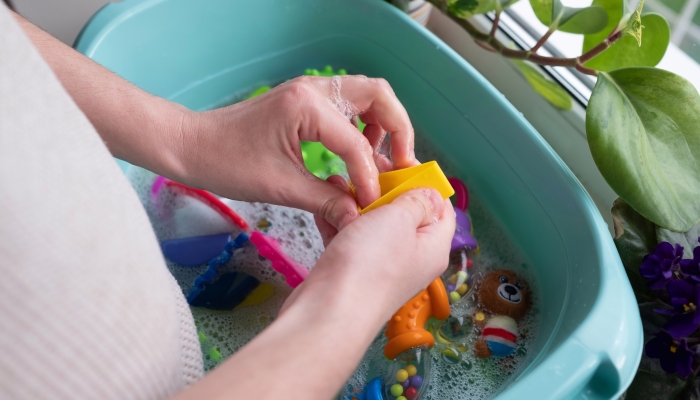
This post may contain affiliate links; please see our terms of use for details.
- If water can get inside a bath toy, mold and bacteria will be able to grow there.
- Use bleach, hydrogen peroxide, vinegar, or Milton’s sterilizing fluid to clean bath toys, inside and out.
- Use a dishwasher, washing machine, or pot of boiling water to kill germs and keep mold at bay.
Bath toys are fantastic. They help prevent bath time battles, develop motor skills, and are so much fun. Who doesn’t love a water fight with squirty rubber ducks? Unless yours are filled with mold and, instead of a nice clean stream of water, they fire black slime across the bath.
Cleaning them can be a worry as you’ll need to use something that’s good at killing mold but won’t damage your child’s skin. Here’s all you need to know about how to clean bath toys safely and effectively.
Why Clean Bath Toys?
If you cut open any of your child’s bath toys or their rubber ducky, you’ll probably find the inside covered with a gooey black substance. At first sight, it looks like mold, but it’s actually biofilm. A community of a huge variety of bacteria and fungi that’s much more resistant to cleaning and between 10 and 1000 times more resistant to antibiotics.
This 2018 study examined 19 real children’s bath toys that’d been used for only 11 weeks. They found biofilm inside every single one. Bacterial numbers reached a stomach-churning 9.5 × 106 cells/cm2. 80% of the toys contained at least one potentially harmful microorganism with the ability to cause eye, ear, gastrointestinal, and urinary tract infections. The microbiologists even found bacteria that cause listeriosis and legionnaires disease.
Should You Ban Bath Toys?
It’s incredibly rare for healthy children to contract these illnesses from their bath toys. Small amounts of exposure could even strengthen their immune systems. Cleaning them is more about preventing the horror of watching all the mold fire across the bath when your child tries to squirt water. It’s also not unheard of for that black slime to contain fecal matter. Yuck!
If your child is vulnerable or has a compromised immune system, you don’t need to ban toys in the bath, but you may need to take extra care. Disinfect them after each use and choose toys that don’t let water collect inside.
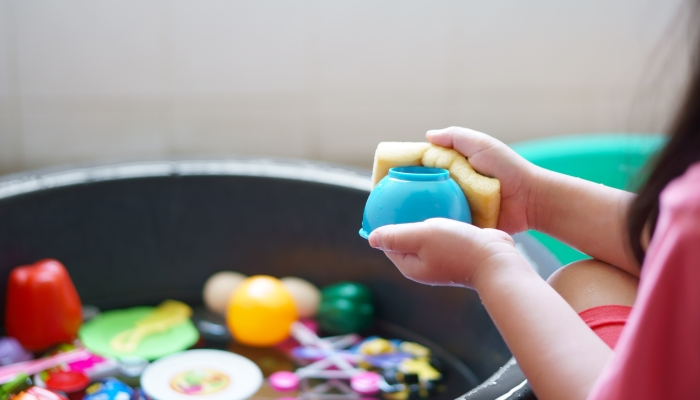
How Often Should Bath Toys Be Cleaned?
Wouldn’t it be great if your kid’s toys’ daily bath was enough to keep them clean and mold-free? Unfortunately, your bathroom’s warm, humid environment is perfect for mold, particularly if the toys are left with standing water inside.
Here are your daily and weekly tasks to keep your bath toys squeaky clean.
Daily
After every bath time, you should:
- Squeeze out any water stuck inside the toys.
- Rinse with soapy water.
- Leave the toys somewhere that’s well ventilated, where they can air dry.
- If your child is immunocompromised, you may wish to wipe the toys with disinfectant wipes.
Weekly
Once a week, you should:
- Scrub the outside of the toys with soap and water.
- Thoroughly disinfect your child’s bath toys.
- Clean the inside of the squirting toys to prevent mold growth.
How to Disinfect and Clean Bath Toys Using Traditional Methods
Start by removing any visible dirt from the surface of the toys. A scrub with a toothbrush, plus dish soap and warm water should take care of most grime.
When the toys look clean on the outside, it’s time to disinfect them and tackle anything that might be trying to grow inside. Bleach is the most effective product for the job but can be harsh and damaging. Vinegar is a less effective but much gentler option. You can even use it to clean wooden toys.
No products found.
| Cleaning Product | Dilution | Method |
| Hydrogen Peroxide | Equal parts water and 3% hydrogen peroxide. |
|
| Bleach | ½ cup of regular bleach per gallon of water. |
|
| Milton Sterilizing Fluid | Between 1 and 3 caps per 5l of water – depending on how dirty the bath toys are. |
|
| Vinegar | Equal parts vinegar and water. |
|
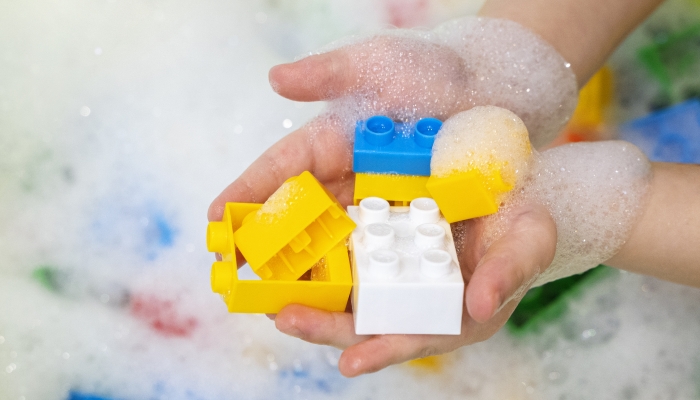
How to Disinfect and Clean Bath Toys Without Chemicals
Children have delicate skin barriers, and they also squirt water from their toys into their eyes and mouth. For this reason, you might want to avoid using bleach or any other chemicals to clean their bath toys.
Fortunately, there are a few methods that are both easy and effective. They also work well to clean lots of other baby toys.
How to Clean Bath Toys Using the Dishwasher
One of the easiest ways to clean bath toys is to put them on the top rack in the dishwasher. The hot water and detergent will kill germs and prevent mold growth on the inside.
Start by testing one toy to make sure it can withstand the heat. You don’t want a dishwasher full of melted rubber ducks! When you’ve established that they’re dishwasher safe, load the toys into the top rack and run on your normal cycle. Allow the bath toys to air dry before you put them away.
The only drawback of this method is that if your toys are already slimy inside, the dishwasher won’t be able to reach it. You’ll have to deal with it by filling and emptying each toy with soapy water first. However, you should only need to do this once, as a weekly washing cycle will prevent new mold from forming.
How to Clean Bath Toys Using the Washing Machine
Another simple way to clean bath toys is to put them in the washing machine. As with the dishwasher, it’s a good idea to test one bath toy first, before you put them all through the wash.
When you’re sure they’ll survive, pop all of your bath toys in a mesh bag or pillowcase and wash them on your regular cycle. You can use your normal detergent. Let the toys dry before putting them away to prevent mold.
If your toys are especially grimy, you may wish to use an antibacterial laundry additive. Whatever you do, don’t pour in a load of bleach. It’ll froth up and flood your house with foam.
How to Disinfect Bath Toys With Boiling Water
Another chemical-free way to clean bath toys is to boil them. Simply bring a large pot of water to a boil and carefully add the toys with tongs. Let them simmer for 5 minutes before you remove them and allow them to dry.
This weekly dose of heat will prevent mold from forming on the inside of the bath toys and is guaranteed to kill any germs.
How to Prevent Mold Growing on Bath Toys
Now you know how to clean bath toys but do you have time to do it? Cleaning bath toys after each bath is a big ask. Especially when you’ve got a fleeing toddler or a baby to get ready for bed.
These simple steps won’t completely eliminate the need for an occasional scrub, but they will ensure you’re not endlessly cleaning bath toys.
Block the holes – Prevent water from getting inside the toys by sealing the holes with a blob of hot glue. If water can’t get into the bath toy, mold won’t be able to grow inside.
Choose easy-clean toys – Look for plastic toys that don’t have any tiny holes or places where water can become trapped. There are lots of options that are still fun for children, boats, fish, and even squirty toys that unscrew so you can clean the insides.
Let the toys dry – If you throw all of the plastic toys in a box after a bath, they won’t get properly dry, and mold will thrive. Instead, let them dry on a rack, ideally next to an open window.
Store the toys somewhere else in the house – The bathroom is warm and humid, ideal for mold. Try to find somewhere well ventilated to store them instead, like in a basket in the hallway.
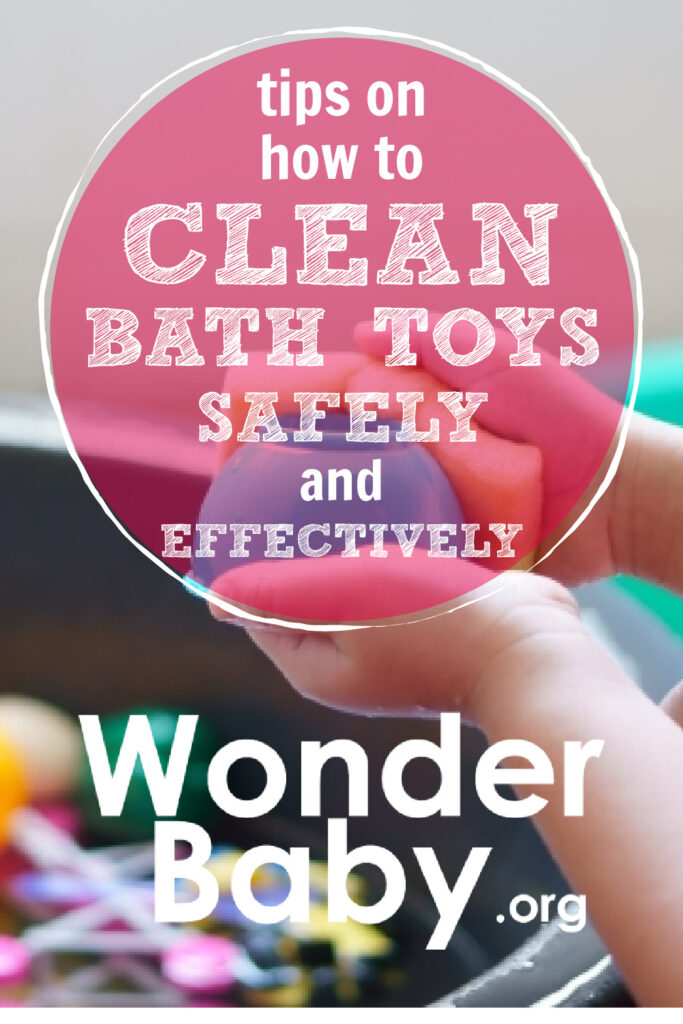
The information WonderBaby provides is not intended to be, and does not constitute, medical or other health advice or diagnosis and should not be used as such. Always consult with a qualified medical professional about your specific circumstances.
Related Posts
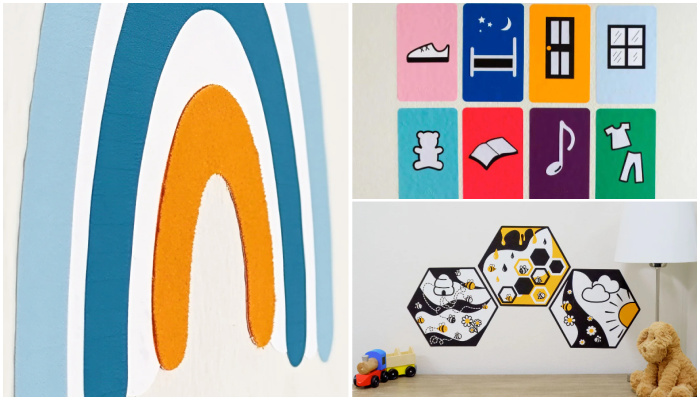
Parenting
Sensory Wall Art: 5 Tips to Create a Room Your Blind or Low-Vision Child Will Love
Even if your child can’t see their surroundings, personalizing and decorating their room with thoughtful, sensory-friendly design can make a big difference in their confidence, independence, and joy.

Braille and Literacy, Toys, Visual Impairment
24 Braille Toys for Kids Who are Blind
Everything from alphabet blocks to raised line coloring pages and activity books to puzzles to card and board games... and so much more! And it's all in braille ready for...
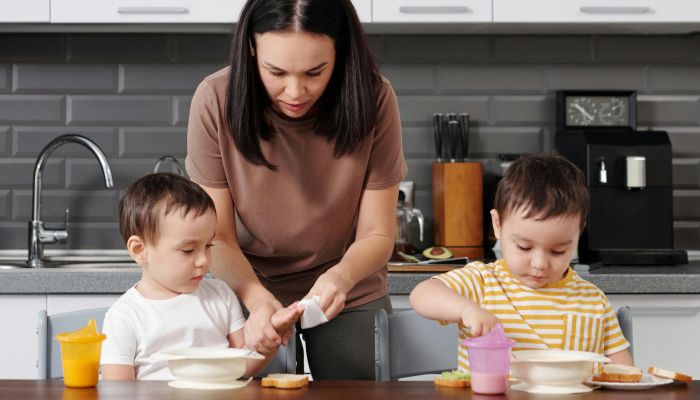
Parenting
4 Tips to Manage Twins Alone as a Single Parent
Taking care of twins alone as a single parent can feel overwhelming. Learn practical ways to help lighten the load.